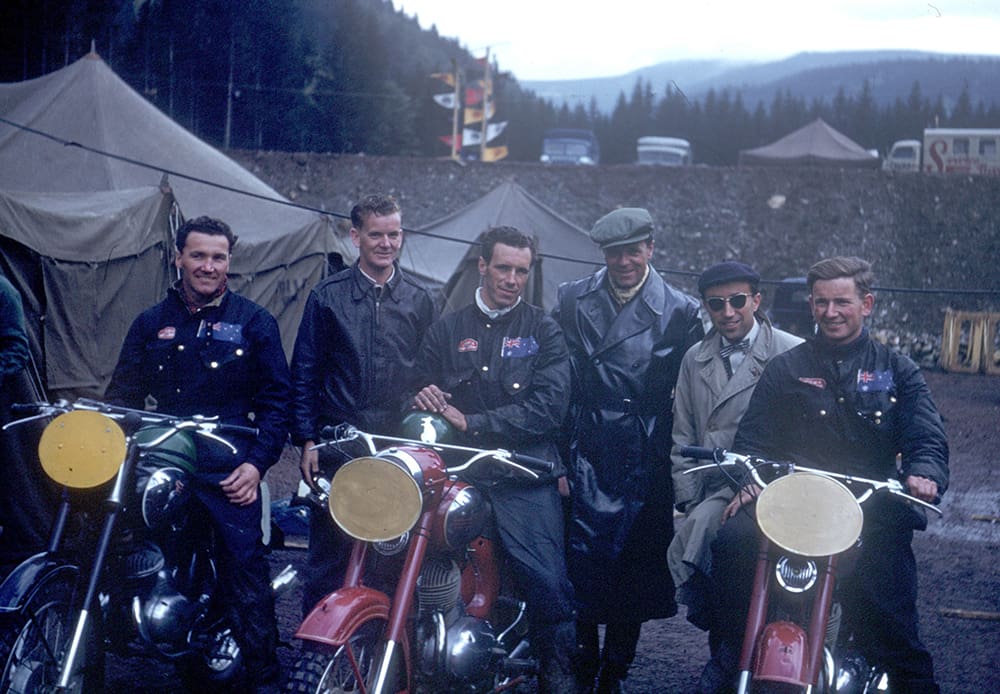Born on the beachhead at Gallipoli, the Anzac Spirit was redefined on the Kokoda Track. But after those hostilities, Aussies turned to kicking some arse in the Old Dart. The tyranny of distance was such that competing overseas usually meant four weeks in steerage, training on corned beef and cabbage. Yet somehow, Maitland born Vic Duggan and his brother Ray managed to save a couple of month’s wages by commandeering a Lancaster bomber in which to transport their hardware to Heathrow.
Vic had enjoyed success before the war, however, in 1947 he proved indomitable in winning the Australian Speedway Championship. Then, in the biggest away game of all, riding his self-built JAP powered machine crafted from T-45 aircraft tubing, Vic won the British Championship in front of 90,000 not so supportive fans at Wembley Stadium. Although the prize wasn’t exactly the crown jewels, Vic did receive his trophy from HRH The Duke of Edinburgh – who much later received a Knighthood from our grateful Prime Minister.
Timed to the nanosecond, contemporary throttle jockeys rip around the Isle of Man at more than 200km/h. Yet there was a time when the circuit was no more than a goat track winding through the fog shrouded mountains, where competitors were clocked by an egg timer, and allowances were made for the first competitor to open the paddock gates, and the last to close them. There was a lot of “trial” on a surface that comprised woodblock, cobblestones, cinders and cowpats.
In 1948, Australia despatched Eric McPherson as our representative at the IOM TT where he crashed in practice. McPherson’s mates Doug Williams and Bill Morgan financed their own jaunt when the trio became Australia’s first team to contest the Grand Prix of Europe. McPherson crashed, Williams suffered a mechanical DNF and only Morgan battled on to finish. It wasn’t an auspicious debut, but when his teammates returned home, Williams stayed on to ride his AJS in the 1948 ISDT held in Italy, and won a trophy as the youngest competitor.
So versatile were our next Manx hopefuls, Harry Hinton and George Morrison, that they limbered up by tackling the notorious Scottish Six Day Trials where Morrison’s engine carked it on the finish line. Noting the absence of an air-conditioned HiAce, Hinton towed Morrison 500 soggy kilometres back to Birmingham.
The duo created an immediate impact at the Isle of Man. While other competitors pussyfooted over the first gear Ballaugh Bridge, both Aussies got plenty of air. Their repute as hard charging larrikins grew in Europe where Morrison, after closely studying the supp regs for the Belgian TT, schemed that both he and Hinton could collect first prize by staging a dead heat. As grid money was their only guaranteed income, that result added to their drawing power – and their wallets.
For all of that, the big money has always been in stadium events. Today it’s supercross, but before effective suspensions were devised, speedway spectacles drew crowds that the Crusty Demons could only dream of. It was standing room only at Wembley Stadium when 26-year-old South Australian Jack Young won the 1951 World Championship. He then went on to create history by winning back-to-back titles.
Huge crowds also attended outdoor events, and dedicated Aussies scattered among the 400,000 hardy spectators lining the pot-holed course for the 1952 Ulster GP were bitterly disappointed when Aussie Ken Kavanagh’s engine exploded in the 500cc race. However as the field completed the first 25km lap of the 350cc race, dismay turned to pride. Kavanagh was on his way to scoring his, and Australia’s, first World GP Victory.
There was definitely something about the beer in Ulster for it was there, only three years later, that Melbourne’s 25-year-old Keith Campbell became Australia’s first MotoGP World Champion. Promoted to lead rider at Guzzi, Campbell was leading the 500cc GP when crankshaft failure stopped his Guzzi V8. However fortune was on his side as he cruised to a win in the following event to secure the 1957 World 350cc Championship.












